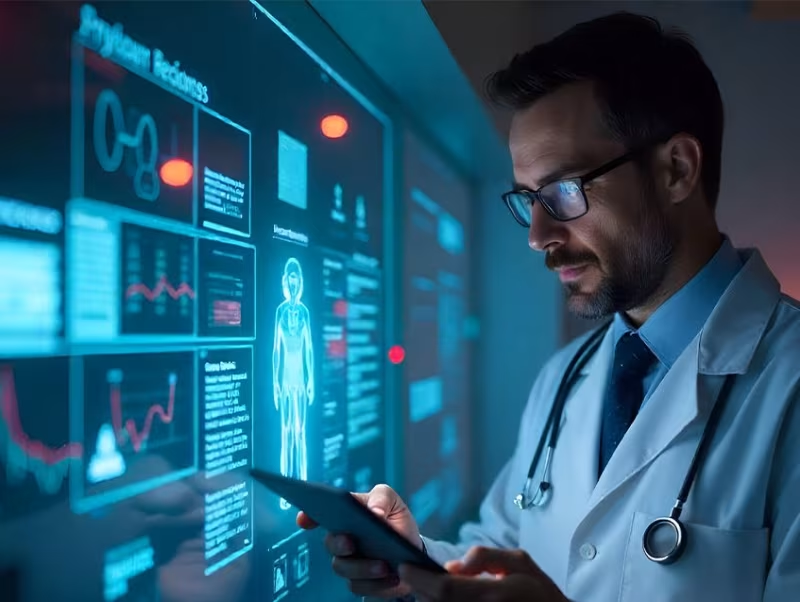Resource / Online Journal
Healthcare Cybersecurity: Strategies to Protect Patient Trust and Data
Explore healthcare cybersecurity effective strategies to secure sensitive data, enhance patient safety, and maintain operational resilience against cyber threats.
Published on Mar 25, 2025

Introduction to Healthcare Cybersecurity
Imagine this, A major healthcare provider suddenly goes offline. Patient records are locked behind a ransomware attack, surgeries are canceled, and critical care is disrupted. The staff urgently works to restore systems as patients’ lives remain at risk. Days later, the news breaks—thousands of medical records surfaces on the dark web. The impact extends beyond operations, triggering lawsuits, fines, and reputational damage.
Cybersecurity in healthcare isn’t just about protecting data—it’s about protecting lives and maintaining trust. Connected medical devices, cloud-based health systems, and electronic health records (EHR) expose healthcare organizations to greater cyber risks. A single breach can cause data theft, operational shutdowns, compromised patient safety, and millions in losses.
For healthcare providers, the stakes are higher than in any other industry. Weak cybersecurity measures don’t just expose sensitive data—they put patient outcomes, trust, and business continuity at risk. In this blog, we’ll explore effective strategies to strengthen healthcare cybersecurity, ensuring both patient trust and operational resilience.
Understanding Healthcare Cybersecurity
Healthcare data breaches have far-reaching consequences beyond financial loss. The health care sector is a prime target for cybercriminals due to the high-value data it holds, including medical histories, genetic details, and treatment plans. A compromised system can delay treatments, disrupt surgeries, and endanger patient safety.
1. Patient Data Protection
Healthcare providers handle vast amounts of sensitive information—medical histories, diagnoses, medications, and even genetic data. A single breach can lead to identity theft, discrimination, and compromised care.
2. Regulatory Compliance
Healthcare Industries are bound by strict industry regulations like HIPAA, which mandate how patient information should be stored, shared, and protected. Failure to comply doesn’t just lead to fines—it can also result in damaged reputations and loss of patient confidence.
3. Incident Response Planning
Even secure systems are vulnerable to cyberattacks, making a strong incident response plan essential. A security incident like, ransomware attack locking hospital systems can delay surgeries and diagnoses. A well-prepared response team can contain the breach, minimize disruption, and restore operations quickly by identifying the attack, communicating with affected parties, and working with cybersecurity experts to prevent further damage. A swift response can turn a crisis into a manageable setback.
Current Cyber Threats in Healthcare
The healthcare sector faced severe cybersecurity challenges in 2024, with ransomware, nation-state espionage, and Internet of Medical Things (IoMT) vulnerabilities emerging as top threats. Cybercriminals used sophisticated ransomware attacks to disrupt operations and demand ransoms. Phishing and compromised credentials remained major risks, allowing unauthorized access to sensitive data. Third-party breaches and data breaches continued to threaten patient privacy and operational integrity.
Latest and Common Cyber-Attacks
1. Ransomware – The most pressing threat, with attacks becoming more advanced and targeted at critical infrastructure. LockBit 3.0 led the attacks with 52 incidents, followed by INC Ransomware (39), RansomHub (36), BianLian (31), and QiLin (23).
2. Nation-State Attacks – Russian group APT29 targeted healthcare with espionage campaigns, while Chinese group UTA0178 exploited vulnerabilities to infiltrate networks. North Korean operatives disguised as remote workers to steal intellectual property.
3. IoMT Vulnerabilities – Medical devices faced security gaps due to poor integration of security in design and development, making them easy targets for exploitation.
4. Supply Chain Attacks – Threat actors targeted third-party vendors to infiltrate healthcare networks, increasing the risk of cascading breaches.
5. Phishing – AI-enhanced phishing campaigns exploited human errors to gain access to critical data, making attacks more precise and effective.
6. Data Breaches – Health data remained a lucrative target on the black market, driving persistent data theft efforts.
7. Bad Bot Traffic – Automated programs targeted patient portals, leading to credential stuffing and data scraping attacks.
8. Cloud Vulnerabilities – Misconfigurations in cloud platforms exposed healthcare systems to data breaches and gain unauthorized access.
Impact of Cyber Attacks on Healthcare
Cyberattacks on medical systems have disrupted diagnostic tools, electronic records, and scheduling, causing canceled procedures and delayed care. Unauthorized access to patient data has led to privacy breaches and legal issues. These attacks on healthcare operations create chaos, compromising patient outcomes and staff efficiency.
Health-ISAC advised healthcare organizations to adopt robust cybersecurity practices by enhancing identity management, securing cloud platforms, and collaborating through threat-sharing platforms to mitigate cybersecurity risk from evolving threats.
Benefits of Implementing Robust Cybersecurity Solutions
Protection of Sensitive Patient Data and Intellectual Property
Implementing strong cybersecurity measures protects sensitive patient data, including electronic protected health information (ePHI) and intellectual property. Healthcare organizations rely on radiology information systems and operating systems to manage large volumes of confidential data, such as medical records and treatment plans. A robust security framework prevents unauthorized access, data breaches, and cyberattacks, ensuring this information remains secure.
In addition to patient data, healthcare organizations generate valuable intellectual property (IP) such as research findings, drug formulations, and innovative treatment methods. Cyberattacks targeting IP can lead to significant financial and competitive losses. Strong cybersecurity protocols protect this critical information from theft and misuse, preserving the organization’s competitive edge and fostering innovation.
The Patient Safety Act and Rule protect patient safety work products, including data on medical errors and safety events, under federal confidentiality laws. This information, which may identify patients and providers, can only be disclosed in limited situations. A secure environment promotes better reporting and analysis, improving patient safety and reducing liability.
Ensuring Compliance with the HIPAA Security Rule and Other Healthcare Laws
Compliance with the Health Insurance Portability and Accountability Act (HIPAA) is mandatory for healthcare organizations. HIPAA’s security rule sets standards for protecting ePHI, requiring healthcare providers to implement administrative, physical, and technical safeguards.
The Patient Safety and Quality Improvement Act of 2005 (PSQIA) also mandates confidentiality protections for patient safety work products. Healthcare providers must ensure that information reported to Patient Safety Organizations (PSOs) remains secure and confidential. PSOs analyze patient safety events and provide insights to healthcare providers.
Failing to comply with these laws can result in financial penalties and reputational damage.
Enhancing Patient Outcomes and Trust in Healthcare Providers
Healthcare cybersecurity directly impacts patient trust and care quality. When patients know their data is protected, they are more likely to engage with healthcare providers and share critical health information. Enhanced security also ensures the safe operation of telemedicine services, protecting remote patient interactions and enabling seamless care delivery.
Collaboration among healthcare providers, government agencies, technology vendors, and cybersecurity experts is crucial to combating evolving cyber threats. Sharing threat intelligence and leveraging cybersecurity resources will strengthen defenses, helping to protect sensitive data, improving patient care and operational efficiency.
Key Cybersecurity Strategies and Solutions
Healthcare organizations face increasing cyber threats, requiring comprehensive strategies to protect sensitive patient data and maintain operational integrity. A well-rounded security framework includes preventive, detective, and corrective measures to minimize risks and respond effectively.
Importance of Security Risk Assessment and Access Control
1. Risk Assessment and Management
Conducting regular security risk assessments helps healthcare organizations identify vulnerabilities and assess the potential impact of security breaches. Understanding these risks allows organizations to implement targeted improvements, strengthen weak points, and allocate resources effectively.
2. Access Control
Implementing strict access controls ensures that only authorized personnel have access to sensitive data and systems. Role-based access management, multi-factor authentication (MFA), and least-privilege principles reduce the risk of unauthorized access and data breaches.
Role of Data Backup and Business Continuity Planning
1. Data Backup
Regularly backing up data ensures that healthcare organizations can recover critical information in the event of a cyberattack, hardware failure, or natural disaster. Backups should be encrypted and stored securely, with both onsite and offsite copies to prevent data loss.
2. Business Continuity Planning
A well-designed business continuity plan (BCP) enables healthcare providers to maintain essential operations during and after a cyber incident. The plan should include clear protocols for incident response, communication, and system recovery to minimize downtime and ensure patient care remains unaffected.
Case Studies of Successful Cybersecurity Implementation
Large Hospital Network Enhances Data Protection and Patient Trust.
Challenge | A large hospital network faced repeated ransomware attacks, compromising patient records and causing system downtime. This led to appointment cancellations and delays in patient care, eroding patient trust. |
|---|---|
Solution | The hospital implemented a zero-trust architecture, multi-factor authentication (MFA), and endpoint detection and response (EDR) solutions. They also introduced regular employee training on phishing and social engineering threats. |
Results | 95% reduction in phishing-related breaches. 30% faster recovery time from system disruptions. Patient satisfaction scores increased by 20% due to improved system availability and faster access to medical records. |
Patient-Centric Impact | Faster access to medical records and test results improved overall patient experience. Fewer appointment disruptions increased patient confidence in the hospital's services. |
Lessons Learned | Employee training and awareness significantly reduce the risk of social engineering attacks. A zero-trust model limits damage even if an attacker gains initial access. Aligning cybersecurity improvements with patient care goals strengthens stakeholder support. |
Future of Cybersecurity in Healthcare
The U.S. Department of Health and Human Services (HHS) plays a critical role in shaping cybersecurity policies for the healthcare sector. In January 2025, HHS proposed updates to the HIPAA Security Rule, introducing mandatory MFA, enhanced vendor oversight, and stricter security risk assessments to strengthen the protection of ePHI. These changes aim to address rising cyber threats but have raised concerns about high compliance costs, projected at $9 billion in the first year, particularly for smaller healthcare providers. To support these organizations, HHS is developing a centralized cybersecurity support system within the Administration for Strategic Preparedness and Response (ASPR). This initiative will streamline access to resources, improve coordination with federal agencies, and provide technical assistance to healthcare providers, reinforcing the sector’s overall cyber resilience.
Conclusion
A single breach can delay treatments, compromise safety, and erode trust. As connected devices and cloud systems increase risks, strong defenses are essential. Compliance with regulations like HIPAA adds another layer of complexity, making it even more critical to adopt robust cybersecurity measures. That’s why choosing the right cybersecurity partner is critical. That’s where TechDemocracy comes in—offering tailored, cost-effective solutions to help healthcare organizations strengthen their defenses and ensure compliance.
Recommended articles


What is The Cyber Kill Chain and How to Use it Effectively
Take Your Identity Strategy
to the Next Level
Strengthen your organization's digital identity for a secure and worry-free tomorrow. Kickstart the journey with a complimentary consultation to explore personalized solutions.